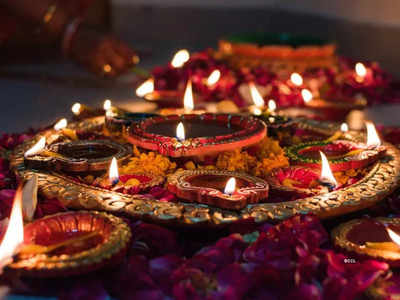
Diwali falls on Amavasya (no moon night) and lighting diyas dispel the darkness, filling the space with light adding meaning to the festival that
signifies the triumph of good over evil.
A lit diya not only illuminates the area but also affects the atmosphere as the temperature rises with lighting the diyas and the pre winter, dense air is cleared. First of all, light a diya in your pooja room, followed by lighting a diya near Tulsi, if you have one at home.Otherwise, light diyas in your kitchen.
To ring in prosperity and wealth, place diyas facing the north or northeast.
For better health, diyas must face east, to banish negativity, protect against diseases, and increase wealth, light diyas near water containers.
Post Lakshmi puja, initiate lighting decorative diyas to welcome her into your home that are sufficiently filled with ghee/oil in order to keep the diya burning all night to ward off darkness and negative energies.
The material of your diyas can also influence the flow of positive energy into your home:
Brass or clay (mud) diyas attract positive vibes and dispel negativity.
Brass, being a good conductor, enhances positive energy, while mud acts as a reservoir of good spirits.
Brass and clay diyas create a joyful and peaceful atmosphere in the home.
Specific colors of lamps can help create a positive and happy home: blue for the north, green for the east, red for the south, dark blue for the west, orange for the southeast, pink or grey for the southwest, and blue or grey for the northwest. Use ghee prepared from cow’s milk, in diyas as it contains sattva element.
Are you confused between straight wicks or puffed
wicks to light diyas ? Don’t worry, we have you sorted
It is always better to use straight wicks instead of puffed wicks as straight wicks invoke the blessings of superior deities and supreme Godheads.
The straight wick signifies the absolute fire element.
This heralds positivity and happiness in the mind of the worshipper.
You can also light an Akhand Diya or Akhand Jyot is an unbroken flame and it holds special significance on Diwali. Diyas that remain lit throughout the night keep evil forces away from your home on the moonless night of Diwali. In addition, a diya that is lit all night is meant to show light and welcome Lakshmi and Ganesha.
Clay diyas: In the northern states of India (Uttar Pradesh, Bihar, and Rajasthan), clay diyas decorated with designs and patterns are preferred that symbolize the Goddess
Lakshmi’s footprints and are believed to ward off evil spirits.
Metal diyas: In South India, intricately carved metal (bronze, brass) diyas are preferred that commemorate Lord Krishna’s victory over the demon Narakasura
Bamboo diyas: In the eastern states of India (Bengal and Odisha), diyas are often made from bamboo and lit with oil, associated with the Goddess Kali, who protects and bestows prosperity.
Written By: Ms. Aarna Jai Madan – Vastu and Interior Consultant
